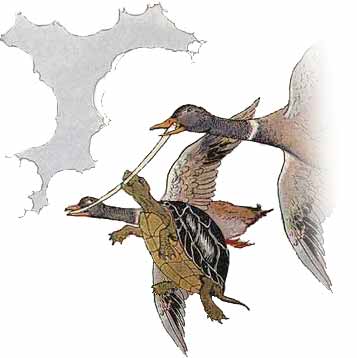The Tortoise and the Ducks 乌龟和鸭 (精美插图) 双语 拼音注音 伊索寓言
标签:伊索寓言 儿童故事集 中英对照翻译 双语故事 拼音注音
Last Update 最后更新: 2022-01-12

The Tortoise and the Ducks (English)
Total Words: 282
The Tortoise, you know, carries his house on his back. No matter how hard he tries, he cannot leave home. They say that Jupiter punished him so, because he was such a lazy stay-at-home that he would not go to Jupiter's wedding, even when especially invited.
After many years, Tortoise began to wish he had gone to that wedding. When he saw how gaily the birds flew about and how the Hare and the Chipmunk and all the other animals ran nimbly by, always eager to see everything there was to be seen, the Tortoise felt very sad and discontented. He wanted to see the world too, and there he was with a house on his back and little short legs that could hardly drag him along.
One day he met a pair of Ducks and told them all his trouble.
"We can help you to see the world," said the Ducks. "Take hold of this stick with your teeth and we will carry you far up in the air where you can see the whole countryside. But keep quiet or you will be sorry."
The Tortoise was very glad indeed. He seized the stick firmly with his teeth, the two Ducks took hold of it one at each end, and away they sailed up toward the clouds.
Just then a Crow flew by. He was very much astonished at the strange sight and cried:
"This must surely be the King of Tortoises!"
"Why certainly—" began the Tortoise.
But as he opened his mouth to say these foolish words he lost his hold on the stick, and down he fell to the ground, where he was dashed to pieces on a rock.
Moral: Foolish curiosity and vanity often lead to misfortune.
乌龟和鸭 (中文翻译 拼音注音)
众所皆知,乌龟总是把家背在背上。无论它多么努力,都不能离开自己的家。人们说,那是朱庇特对它的惩罚,因为它又懒又宅,即便是特意邀请它去参加朱庇特的婚礼,它也断然拒绝了。
很多年过后,乌龟就后悔当初没有去参加朱庇特的婚礼。每当看着鸟儿们欢快地翱翔,野兔和花栗鼠等动物迅捷地跳跃,就十分渴望去看看这个世界,这令它伤感而忧郁。它也想去看看这个世界,但背上的家、短小的腿,都令它寸步难行。
有一天,它遇到了两只鸭子,就向它们倾诉了自己的苦恼。
“我们可以带你去看世界,”鸭鸭们说道。“用你的牙齿紧紧咬住这根棍子,我们飞着把你带到空中,那样你就可以鸟瞰整个世界了。但是,请务必不要说话,否则你会后悔的。”
乌龟对此高兴极了。它紧紧咬住棍子,两只鸭子各持一端,就飞上云霄了。
就在那时,一只乌鸦碰巧飞过。它对这奇特的现象感到惊诧,就惊叹道:
“这定是龟王!”
“那是当然了” 乌龟说道。
可是,正当它愚蠢地开口说话时,它松开了自己口中的棍子,就从高空坠落到地面,在一块石头上摔了个粉碎。
Relevant Fables 相关寓言故事
About 关于
The Aesop Fables for Children 伊索寓言儿童故事全集 (图文英汉双语版) (this work), the english fables originally from The Aesop for Children: with Pictures by Milo Winter published by Rand, McNally & Co in 1919. Some of pictures come from Library of Congress. This work is considered to be in the public domain in the United States. The Aesop Fables for Children contains the text of selected fables, color pictures, video, and interactive animations, and will be enjoyed by readers of any age.
The Aesop Fables for Children are a collection of stories designed to teach moral lessons credited to Aesop, a Greek slave and story-teller thought to have lived between 620 and 560 BCE.
Aesop's fables are some of the most well known in the world and have been translated in multiple languages and become popular in dozens of cultures through the course of five centuries. They have been told and retold in a variety of media, from oral tradition to written storybooks to stage, film and animated cartoon versions—even in architecture. This page include translation to Simplified Chinese.
伊索寓言是一部世界上最早的寓言故事集,是世界文学史上流传最广的寓言故事之一。 本文包含伊索寓言故事英文原文和简体中文翻译(中英双语)。




